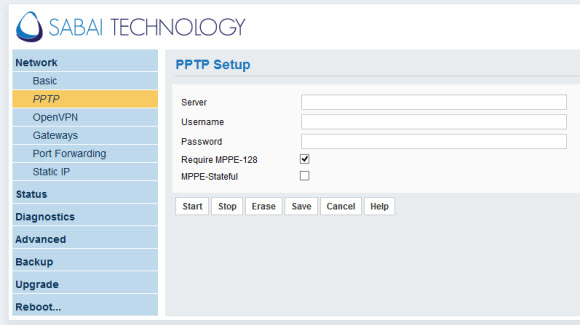We recently upgraded our Cisco Linksys E3000 router from Sabai OSv4 to the newly released Sabai OSv5. The upgrade process was a breeze. Taking less than 10 minutes to update and reset the router. We were immediately reconnected to our network. After quickly receiving a new activation code we were able to once again enjoy the advanced features of the Sabai router. Including VPN, gateways and port forwarding.
This isn’t our first time using a Sabai router. We actually had our first experience with Sabai Technology in 2011. After a nice chat with the owner, William Haynes, we tested their custom Tomato firmware and have been a fan of VPN routers ever since then. Last year brought Sabai OSv4 which had some nice innovative features built-in. Adding support for port forwarding and allowing users to set up a dual gateway.
Let’s take a look at the new interface design in Sabai OSv5:

Those familiar with the layout of OSv4 won’t be lost at all. You still have the same basic layout in OSv5. With a cleaner look and feel. The Network tab still includes your PPTP and OpenVPN connections. Along with Gateways and Port Forwarding. Sabai changed the name from dual gateway to gateway because those running their accelerator product can actually set up a tri-gateway now.
Sabai OSv5 Performance Review
Now that we had the firmware up to date it was time to fire up some VPN and see how the router performs. First we’d like to note that new Sabai customers won’t have to bother with upgrading to OSv5. As the new OS comes standard on all their routers. Now back to the testing. First we tested without connecting to a VPN. Then we connected to IPVanish through their client. Finally connecting to IPVanish thru the Sabai router.
Here are the results of our VPN performance testings:
- Speed without a VPN connection – 45.50 Mbps
- Speed with IPVanish client software – 35.71 Mbps
- Speed with IPVanish thru the router – 27.97 Mbps
As you can see we were able to achieve good performance through the Sabai E3000 router. It was a bit slower than connecting through the IPVanish client directly but that’s to be expected. If you want maximum speed then consider Sabai’s VPN accelerator product. For us the speed was more than acceptable.
New Features in Sabai OSv5
The first thing we noticed about Sabai OSv5 was the new interface design. There wasn’t anything functionally wrong with the design of OSv4 but the new design is better on the eyes. The same features are available in OSv5 with some major improvements. First you have a number of new OpenVPN configuration options. Along with enhancements to the Gateway feature and improved stability for those running Sabai’s VPN accelerator.
Let’s take a quick look at the expanded OpenVPN capabilities in OSv5:
- Sabai routers are now compatible with:
- VPN providers who offer a unified .ovpn file with inline certs, keys and passwords, such as StrongVPN.
- VPN providers who offer an array of external files such as .certs and .keys, usually in a zip file.
- VPN providers who offer either a single .ovpn file or an array of files and require a username/password.
As you can see Sabai put a lot of effort into their new OSv5 release. We hope you’ve found our review helpful. You can visit SabaiTechnology.com to learn more about OSv5 and check out their full line of VPN routers.



